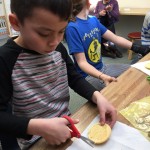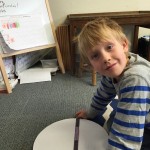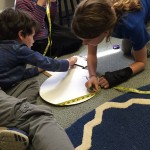

Next, we read the story, Sir Cumference and the Dragon of Pi by Cindy Neuschwander. In the story, a boy solves a riddle to cure his father who drank a potion that turned him into a dragon. The answer to the riddle is the magic number that is the same for all circles: pi. The literature experience helped reinforce the discovery the students had made because the boy in the book experimented to figure out how many diameters are equivalent to the circumference of a circle to find pi just as the Bixby students had.
According to Jerome Bruner, the psychologist credited with originating discovery learning, “True learning involves figuring out how to use what you already know in order to go beyond what you already think.” It was then important for students to explain and apply the relationship for themselves. When asked to explain what they know about pi now, one student said, “If we knew the length of the circumference and the length of the diameter and divided the circumference by the diameter that would be pi.” Later I asked how pi was useful, and another student said, “If you didn’t know the diameter and divided the circumference by pi then you could find the diameter, or if you don’t know the circumference but you know the diameter, then you could multiply the diameter by pi to find the circumference.”
As these young mathematicians use procedures to find out about round objects in the future, my hope is that their application of the formulas will be based on real understanding because they discovered the relationship through their own experiences and developed the formula for themselves. As Alfie Kohn, proponent of progressive educations says, “What distinguishes progressive education is that students must construct their own understanding of ideas,” and construct ideas is what Bixby students did on Pi Day.
-Dana
“Knowing how something is put together is worth a thousand facts about it,” Jerome Bruner




